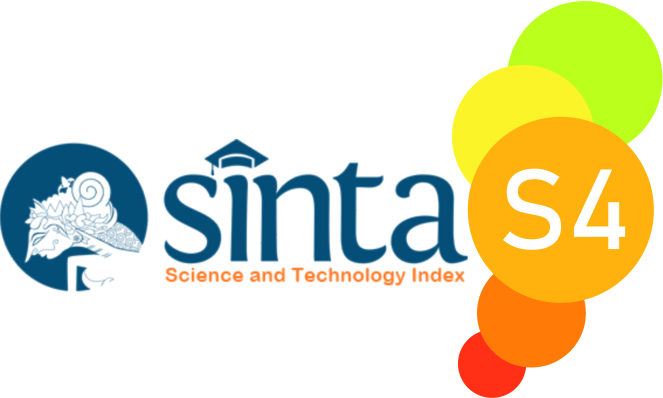Relationship Betweenparticipant’s Learning Readiness Educate Through Onlinewith the Learning Results on English Courses
 ), Setiawati Setiawati(2),
), Setiawati Setiawati(2), (1) Universitas Negeri Padang
(2) Universitas Negeri Padang
 Corresponding Author
Corresponding Author
DOI : https://doi.org/10.24036/spektrumpls.v9i3.113233
Full Text:
 Language : en
Language : en
Abstract
This research is based on the low learning outcomes of students online in English courses at the English Tutorial Center Padang, it is suspected that there is something to do with students' readiness to learn. The purpose of this study is to reveal: (1) a description of students' readiness to learn online, (2) student learning outcomes in English courses at the English Tutorial Center Padang, and (3) reveal the relationship between students' readiness to learn online and learning outcomes in the English course at the English Tutorial Center Padang. This type of research is descriptive correlational research through a quantitative approach. The population of this research is English course students for the period of July - August 2020, totaling 35 people and a sample of 70%, namely 24 people with cluster random sampling technique. The data collection technique used is a questionnaire and the tool used is a questionnaire. The data analysis technique used the percentage formula and the spearman rho formula.The results of this study indicate that: 1) students' online learning readiness in English courses at the English Tutorial Center Padang is low; 2) student learning outcomes in English courses at the English Tutorial Center Padang are low; 3) there is a significant relationship between students' readiness to learn online and their learning outcomes in English courses at the English Tutorial Center Padang. The suggestion of this research is that the manager of the English course at the English Tutorial Center Padang should provide facilities that will be used during learning so that it can foster enthusiasm and readiness to learn students. Instructors should be creative when using learning media so that they can bring up the enthusiasm and readiness of students to learn in the implementation of learning activities.
Keywords: Learning Readiness,Learning Outcomes
References
Afriana, Afriana, R., Wisroni, & Setiawati. (2018). Hubungan Komunikasi Interpersonal Tutor Dengan Hasil Belajar Bahasa Inggris Paket B Kelas VIII di PKBM Sakido. Spektrum: Jurnal Pendidikan Luar Sekolah, 1(1). Retrieved from http://ejournal.unp.ac.id/index.php/pnfi/article/view/9010
Audihani, A. L., Hidayah, F. F., & Ristanti, D. A. (2019). Analisis kesiapan belajar peserta didik dalam proses pembelajaran kimia materi hidrokarbon 1. Seminar Nasional Edusainstek, 149– 156. Semarang: FMIPA UNIMUS. https://doi.org/ISBN : 2685-5852
Audina, S. F., & Muhtadi. (2019). Strategi Keberhasilan Usaha Home Industry Sepatu Dalam Memberdayakan Masyarakat. Journal Agribisnis Terpadu, 12(1). Retrieved from https://jurnal.untirta.ac.id/index.php/jat/article/view/5539/4004
Agung Gunawan, I. (2021). Relationship of Active Participation in Mosque Youth Activities with Youth Social Behavior in Kuranji Village, Guguak District, Lima Puluh Kota Regency. SPEKTRUM: Jurnal Pendidikan Luar Sekolah (PLS), 9(123–132).
Bartin, T. (2018). Pendidikan Orang Dewasa Sebagai Basis Pendidikan Nonformal. Jurnal TEKNODIK, 10(19), 854–915.
Djamarah, S. B. (2012). Psikologi Belajar. Jakarta: Rineka Cipta.
Intan Suci Aulia, S. (2021). Relationship Between Learning Media and Learning Motivation for Participants in Bread and Cake Making Training at BLK Batusangkar. SPEKTRUM: Jurnal Pendidikan Luar Sekolah (PLS), 9(1), 139–144.
Jayatra, R. (2018). Analisis kesiapan belajar pada siswa kelas viii sekolah menengah pertama negeri 1 serasan timur tahun ajaran 2018. 1–12.
Mendikbud. (2020). Surat Edaran Menteri Pendidikan dan Kebudayaan Nomor 4 Tahun 2020 tentang Pelaksanaan Kebijakan Pendidikan dalam masa Darurat Penyebaran Coronavirus Diese (Covid-19). Jakarta.
Mitra, N. (2015). faktor-faktor yang mempengaruhi hasil belajar. In asik belajar belajar tanpa batas. Nasution, S. M. (2011). Resiliensi. Daya Pegas Menghadapi Trauma Kehidupan. Medan: USU Press.
Setiawati, & Aini, W. (2019). Meningkatkan Motivasi Belajar Orang Dewasa Melalui Pengenalan Kebutuhannya. Kolokium: Junal Pendidikan Luar Sekolah, 7(2). https://doi.org/10.24036/kolokium-pls.v7i2.36
Slameto. (2010). Belajar dan Faktor-Faktor yang Mempengaruhinya. Jakarta: Rineka Cipta.
Slameto. (2015). Belajar dan Faktor-faktor yang Mempengaruhinya. Jakarta: Rineka Cipta.
Sudijono, A. (2011). Pengantar Statistik Pendidikan. Jakarta: PT Raja Grafindo Persada.
Sudjana, N. (2016). Penilaian Hasil Proses Belajar Mengajar. Bandung: Rosdikarya.
Suprihatiningrum, J. (2016). strategi pembelajaran. Jogjakarta: AR-RUZZ MEDIA.
Surya. (2010). Psikologi Pembelajaran dan Pengajaran. Pustaka Bani Quraisy.
Thobroni, M., & Mustofa, A. (2013). Belajar & Pembelajaran: Pengembangan Wacana dan Praktik Pembelajaran Dalam Pembangunan Nasional. Yogyakarta: Ar-Ruzz Media.
Wasti, S. (2013). Hubungan Minat Belajar Dengan Hasil Belajar Mata Pelajaran Tata Busana Di Madrasah Aliyah Negeri 2 Padang.
Wela Melisa Putri, J. J. (2021). Relationship between Educator Supervision and Discipline Behavior of Santri at the Tahfidz Nurul Ilmi Kuranji House, Padang City. SPEKTRUM: Jurnal Pendidikan Luar Sekolah (PLS), 9(1), 96–102.
Winkel, W. s. (2007). Psikologi Pengajaran. Yogyakarta: Media Abadi.
 Article Metrics
Article Metrics
 Abstract Views : 258 times
Abstract Views : 258 times
 PDF Downloaded : 90 times
PDF Downloaded : 90 times
Refbacks
- There are currently no refbacks.

This work is licensed under a Creative Commons Attribution-NonCommercial 4.0 International License.



